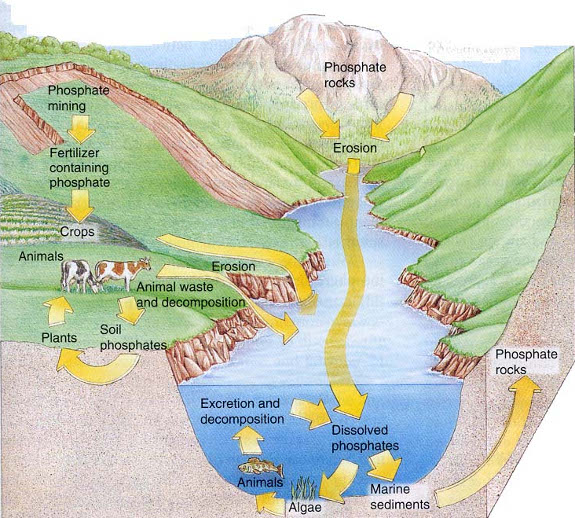
Excess phosphorus in the soil
The last thorny soil
issue I want to cover is phosphorus. Steve
Solomon's worksheets
aim for an equal amount of phosphorus and potassium in the soil, while Michael
Phillips thinks more phosphorus is better and recommends building
orchard soil to have twice as much phosphorus as potassium. On
the other hand, Harvey
Ussery explained
that excessively high phosphorus levels cause a decline in mycorrhizal
fungi, which means that plants actually have a harder time finding enough
phosphorus and can experience a deficiency. In a worst case
scenario, extra phosphorus can even wash into streams and cause
eutrophication. Fertilizing with manure (especially chicken
manure) boosts phosophorus levels in the soil quickly, so the question
is --- should I be concerned about phosphorus excesses?
| Location | lbs P2O5/acre | Deficit or excess P |
| Powerline pasture | 56 | −237 |
| CP3 and CP4 | 225 | −209 |
| CP5 | 117 | −196 |
| Forest aisles | 269 | −127 |
| Blueberries | 345 | unsure |
| Front berries | 778 | −21 |
| Forest garden | 1136 | 180 |
| Back garden | 1599 | 354 |
| Front garden | 2029 | 487 |
| Mule garden | 2246 | 551 |
Using Solomon's
recommended phosphorus levels, it's clear that our native soil is low
on phosphorus, but that my preferred horse manure fertilizer has
increased levels within the vegetable garden beyond the recommended
range. Of course, if I was using Phillips' goal instead of
Solomon's, the vegetable garden would actually be considered deficient
in phosphorus like the rest of our homestead.
Solomon backs up
Phillips by writing that excess phosphorus is seldom a problem since it
will actually increase the nutrient density of your produce. In
fact, in a perfect world, Solomon believes our soil would have 2,000
to 5,000 pounds of phosphorus per acre, at which level enough of the
mineral would
naturally be released each year to feed our crops with no additional
applications of fertilizer. Based on these figures, I suspect we
can carry on with my heavy manuring for another five or so years before
phosphorus levels in our vegetable garden exceed biologically healthy
amounts.
On the other hand, my
readings suggest that excess phosphorus can be an issue in the blueberry
patch, where the
extra phosphorus can cause some of the same deficiency symptoms you'll
notice from high pH or high calcium levels. I doubt that we're
anywhere near that level yet, but it might be worth focusing on
building acidic, low phosphorus, low calcium compost for that patch for
the future. And, one of these days, I'll probably have to escape
my reliance on off-farm manure and bring our homestead into more of a
closed loop. Stay tuned for a lunchtime series based on How
to Grow More Vegetables on that very topic soon.
This
post is part of our The Intelligent
Gardener lunchtime series.
Read all of the entries:
|
Want more in-depth information? Browse through our books.
Or explore more posts by date or by subject.
About us: Anna Hess and Mark Hamilton spent over a decade living self-sufficiently in the mountains of Virginia before moving north to start over from scratch in the foothills of Ohio. They've experimented with permaculture, no-till gardening, trailersteading, home-based microbusinesses and much more, writing about their adventures in both blogs and books.
Want to be notified when new comments are posted on this page? Click on the RSS button after you add a comment to subscribe to the comment feed, or simply check the box beside "email replies to me" while writing your comment.


Jeremy --- Excellent question. I've been meaning to write more about urine, but I'm actually not very scientific about it, so I don't have much to say yet. (I mostly just fill buckets with pee and pour them on woody mulches around perennials, moving to a new spot each time.) I think you're definitely right that diluted urine could replace seed meals in Solomon's system, but I haven't done the math to see how much you should apply.
Urine is lower in phosphorus --- NPK is about 11-1-2.5 --- which means that providing the deficit of 200 lbs/acre in our less-managed areas would require about 20,000 pounds of pee per acre. That's not terrible, though, since I fill up a five gallon bucket with pee about once a week, which is about 80 pounds per week or 4,160 pounds per year. So, if I played my cards right, I could eliminate the phosphorus deficit for a fifth of an acre every year.
(Assuming I did my math right --- my head's a little sleepy right now...)